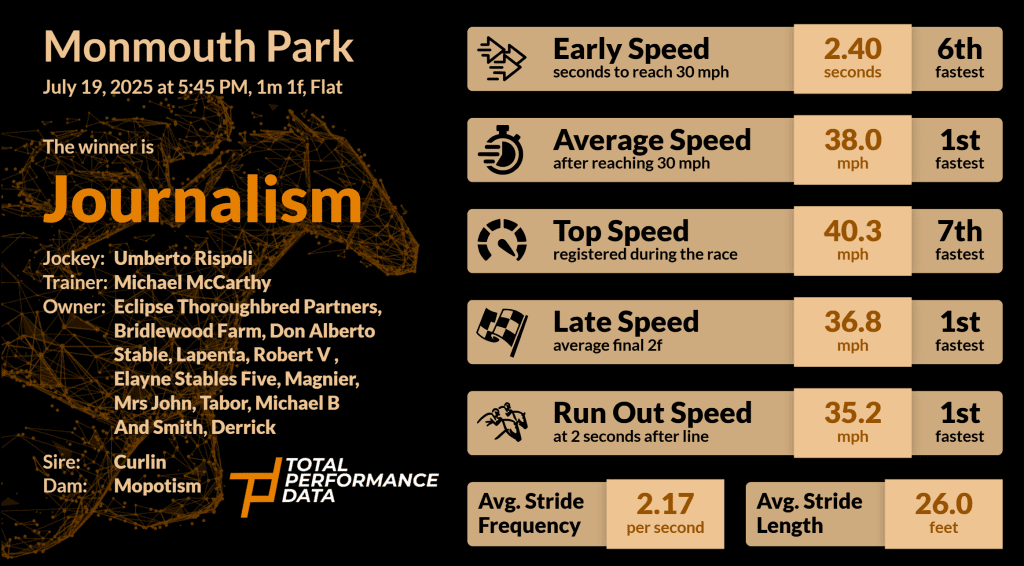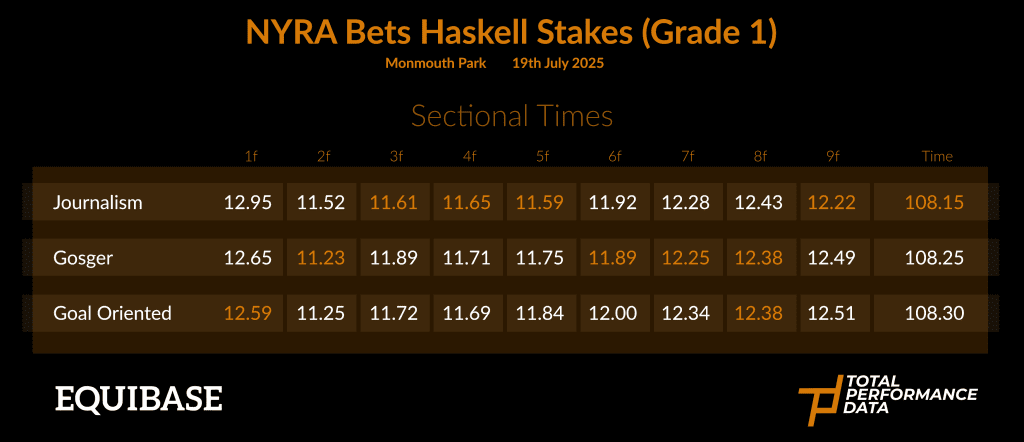NYRA Bets Haskell Stakes


“Journalism writes his own headlines”
Alright. That’s a slightly unnecessary headline, but this was a truly special performance from Michael McCarthy’s charge and I suspect that in any other year, we might be discussing Journalism as one of the best 3-year-olds of the 21st Century. The fact that we aren’t is testament to how much his rival has achieved, but this performance was certainly close to matching a career best performance from this son of Curlin. A winning time of 1:48.15 is perhaps only par for the course and the likes of Maximum Security (2019), Mandaloun (2021) and Cyberknife (2022) have run faster times. However, the nature of this year’s race and in particular the manner in which Journalism broke from the gate probably put paid to any chances of an enormous time figure. He certainly doesn’t make things easy for Umberto Rispoli. Having been restless in the gate, he struggled to gather stride and had to be driven hard by Rispoli to pick up the pace, recording a slow opening furlong in 12.95s (ranked 7th of 8) which left him 6-lengths off the pace as the field turned into the back straight. That slow start probably forced Rispoli into an early race move, where he made ground on the leaders with the fastest 3rd and 4th furlongs in the race. Rounding the turn 3-wide, for a brief moment it looked like the leaders had held the inside ground and got away from him, but it was at that point that Journalism’s exceptional class came into play. Galvanised under the Rispoli drive, Journalism reached deep into his reserves of stamina to quicken into the final furlong, the only horse in the field to find extra pace in the home straight as he stretched his average stride length from 7.5 to 7.56m. That allowed him to make up the ground and gallop on through the line with the fastest run-out speed in the field at 35.19 mph. A race finishing speed of 96.6% meant that this wasn’t the end-to-end gallop that we sometimes associate American dirt racing with, but that only adds to the sense of disbelief that Journalism was able to get there given the passage he endured. This performance shouldn’t be underplayed as it took an enormous effort to run down the leaders in the straight, but as much as this victory in the Haskell Stakes will leave a lasting impression, it only adds to the ultimate question at TPD; how good is Sovereignty?


I think that it is important to offer some praise to the placed horses too. Gosger has confirmed the form from his unlucky defeat in the Preakness Stakes and whilst we can say with some certainty that there are a couple of better 3-year-olds in the US this year, he is consistently running to a level that should prove sufficient to win a Grade 1 when they’re not around. Unlike the Preakness Stakes, there was no element of doubt about this defeat and he seems unlikely to reverse the form with Journalism any time soon, but he was the fastest horse in the 7th and 8th furlongs of the contest and recorded a higher top speed figure than the winner at 41.38 mph. Having started on terms with opening furlongs that ranked 5th, 4th, 6th and 3rd, he had the ideal position behind the pace and Luis Saez must have been fairly pleased with his situation at halfway. If you had offered him a 4-length lead over Journalism at the end of the opening quarter of a mile he would certainly have taken it. Pushed forwards around the far turn, there is a brief moment in time where Luis Saez looks under his right shoulder and spots Journalism coming to his rear. From there he kicks his mount forwards and gains an advantage by holding a tighter line into the straight, but it isn’t enough. Both horses recorded a peak average stride frequency of 2.21 per second, but it is their stride length that ultimately proves to be the difference between the pair. Journalism recorded the highest average stride length figure in the field at 7.91m and unlike Gosger, he was able to lengthen in the final furlong to get the job done. Brendan Walsh’s charge was unlucky in the Preakness, but he ran a very similar race at Monmouth Park on Saturday and was firmly put in his place. There’s a case to be made that he ranks in the top 5 three-year-olds in the US this year, but he is a long way behind the big 2 and seems unlikely to climb any higher.
I will always try and find another angle with these review pieces and so whilst it’s unlikely that this form will be reversed if the main players meet again, I think that it’s important to note that Goal Oriented did close the gap from the Preakness Stakes and after just 4 starts, he is likely to still have some improvement to come. Stall 8 probably forced Flavien Prat to commit from the stalls and it wasn’t a great surprise to see him ridden forwards behind the leader. Having been pushed to the front around the turn, he enjoyed an ideal trip and ultimately wasn’t able to repel the winner in the straight, but he did equal the time for the fastest penultimate furlong with Gosger (12.38s) and at a race average of 2.25 per second, he had the highest stride frequency figure in the field. He couldn’t go with the principles in the Preakness after getting involved in a barging match with Journalism at the top of the straight, but he traveled very strongly into that race and on both occasions he has recorded a higher top speed figure. I can’t make any excuses for this defeat and the fact that Journalism has a much longer stride is always going to make things difficult, but with every start Bob Baffert’s 3-year-old is improving and he may yet be capable of taking a further step forwards.